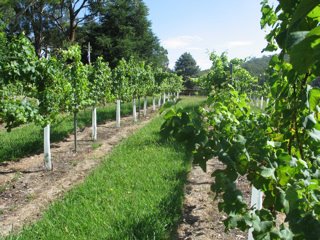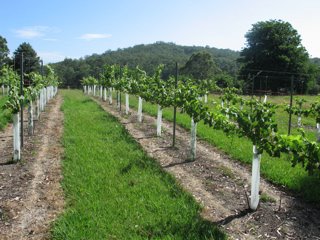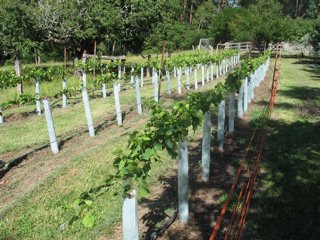The Semillon has performed the best with substantial new growth. The cuttings for this block come from another local vineyard where the clone(s) is unknown. Some individual vines are far outperforming others. Whether this is clonal or environmental is anyone’s guess. Cuttings will be taken from these particular vines during dormancy and grown on next season to ascertain the answer.

The Semillon Rows
The cordon wire has been filled in most cases with lateral growth ie. potential spurs, on the first half of the new cordon acceptable. The top row has not performed as well due to severe soil compaction at one end and tree competition at the other. This could be overcome next season by digging up these vines during dormancy, completely removing a volume of compacted soil that accommodates major feeder root growth, mixing it with organic matter and replacing it. The vine can be then replanted, cut back and retrained or the better performing cuttings planted. This soil improvement system has worked for a number of the Tempranillo in the same block. The competing trees need to be cut back.
The Tempranillo has also performed well with some problems with tree competition at the lower end of the block. This will require additional soil amelioration. We know the clone of this variety (D8V12) but again there has been a few outstanding performers so the question of clonal variation versus environment will have to be answered. We will repeat the cutting exercise with these as well. One vine in particular is stunted with quite distorted leaves. This could be a viral problem and that vine will be destroyed and replaced.

The Tempranillo Rows
The Pinot Noir growth has been even (MV6 clone) but considerably less vigorous than the other two. This is a typical characteristic of the variety.
Whether there has been enough growth for spuring can only be assessed at the end of the season. It could be that they will need to be cut back to 2 buds and retrained.
It is said that Pinot Noir needs deep, friable, mineral rich, moist soil. Thick clay sub soils and lean sandy top soils do not deliver the best results. We have the latter here.
Good quality fruit is produced in cool humid regions (Burgundy, Yarra Valley, Mornington Peninsula, New Zealand), not in hotter climates where color and phenolic components are inadequate. We have the latter here.
So it is evident we will have trouble theoretically producing a decent (complex, multi layered) wine from our Pinot. It might just be a source of grapes for an acceptable summer Rose’.
However we are trying other cultural techniques to improve quality.
We are planting the vines close together (1mx3m) or 3333/ha. In France they can be planted at a density of 10,000/ha or 1mx1m. This higher density planting reduces vigor and limits the vine’s fruit production. Some say that yield should be around 750g per vine, or in our case 2.5 tonnes/ha. to achieve good quality.

The Pinot Noir Block
Clonal selection is important. There are around 30 clones of Pinot Noir available in Australia. Vines need to be fruitful but produce even sized bunches with small berries. Shoots should not be too vigorous. MV6 seems to fit this bill but its performance is very site specific and we have yet to full ascertain what this clone will do in our environment.
Canopy management is also important. Vertical Shoot Positioning (VSP) and avoidance of leaf shading is essential prevent acid imbalance, herbal flavor development and poor phenolic composition.
So it is an interesting experiment to grow this variety on this site in this climate.
You don’t have to be crazy to be a viticulturalist but it helps.




















No comments:
Post a Comment